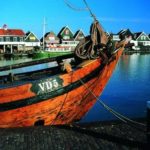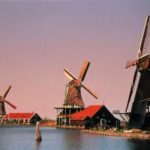A web of 17th canals criss-cross Amsterdam
By Victor Block
World-class museums stand shoulder-to-shoulder with flower markets festooned by rainbows of color. People crowded into cafes and pubs chat, sip coffee and other beverages and watch the passing traffic, which consists of as many bicycles as automobiles.
This is the setting in one of the greatest small cities in the world, which is the capital of one of the smallest countries in Europe. But anything that the Netherlands may lack in dimension – it’s about twice the size of Massachusetts – it more than makes up in diversity.
Visitors soon understand why the name Netherlands, which means “lower countries,” is a perfect fit. Much of the land has been reclaimed from the North Sea and lakes, and more than one-quarter of the pancake-flat area is beneath sea level. It’s protected by an elaborate drainage system of canals, dikes and pumping stations. Windmills pump water back over the dikes, as well as milling flour and other grains.
Amsterdam offers appeals that would make a much larger metropolis proud. A web of 17th-century canals criss-cross the city, and boat tours are a popular way to take in many sights. Elegant homes that were built by wealthy residents during the 17th century “Golden Age” overlook the canals and cobblestone streets.
Belying Amsterdam’s modest size are more than 70 museums, ranging from world-class to intimate. The Rijksmuseum, the country’s national showplace, houses the most extensive collection of Dutch paintings in the world. The exhibits include nearly two dozen Rembrandts, enough alone to warrant a visit.
A priceless collection of works by Rembrandt also resides in the Rembrandt Huis, where the artist lived from 1639 to 1658. My favorite, the “View of Amsterdam,” depicts a row of windmills lined up like soldiers in formation.
The Van Gogh Museum contains the largest number of masterpieces by that renowned artist. They include about 200 paintings and 500 drawings.
Much smaller, yet certainly as well known, is the Anne Frank House. In this narrow townhouse, the young Jewish girl lived for more than two years in hidden rooms with her family and four other people, during the German occupation of the Netherlands in World War II.
Among items on view are Anne’s hand-written diaries. Her observations and reminiscences, some heartening, others chilling, have been translated into more than 70 languages.
Even with the many treasures that Amsterdam has to offer, countless other attractions await those who include visits to a sampling of the country’s rural villages. Their tranquil charms and laid-back personality present a different, yet equally as appealing, face.
Delft once was the world center for production of graceful Royal Delft Pottery, with 32 factories that produced ceramics with the distinctive blue and white colors. While only one factory remains, the town also has buildings dating from as early as the 13th century along with museums, markets and other reasons to visit.
The area around IJsselmeer Lake is dotted with inviting old towns. The fishing villages of Monnickendam, Marken and Volendam epitomize charm, Edam is famous for the cheese produced there and Hoorn, Enkhuizen and Stavoren combine history with their own unique appeals.
A different experience awaits visitors to Giethoorn, a village that is reached by water and prohibits the use of cars. Locals traverse the four miles of canals in small flat-bottom boats, and many farmhouses have a thatched roof dating back to the 18th century.
A contrasting atmosphere is encountered in Maastricht, a city of about 120,000 residents at the southernmost tip of the Netherlands. It combines some of the best features of the country with touches of France and Belgium. The result is an enticing amalgam of history, sightseeing and activities.
The people exhibit the characteristic Dutch friendliness and dry sense of humor. The joie de vivre of the French is evident in crowded cafes, tempting patisseries and boutiques displaying the latest Paris fashions. Even the surrounding countryside provides a different touch, resembling the rolling hills of nearby Belgium more than the flat lowlands characteristic of the Netherlands.
Residents of Maastricht revel in their city’s reputation as a place for fun and frivolity. They’re quick to point out the statue of the Spirit of Maas, a dancing sprite that combines a look of joy with a hint of naughtiness. They also note that their town contains a church for every week of the year, but a bar for every day.
At the same time, locals take pride in their city’s history and reminders of its past. It has some 1,450 historic buildings and monuments. Most are crowded into the town center. he mid-17th century Stadhuis (city hall) boasts a decorative interior enhanced with Brussels tapestries and painted ceilings.
The Medieval Basilica of St. Servatius was begun in the sixth century, making it the oldest house of worship in the Netherlands. Of particular interest is the largest bell in the country, a 150,000-pound clanger affectionately called “Grameer” (Grandmother), and ancient crypts.
Even a local hotel, the Derlon, displays ties with the past. An archeological area in the basement spans several centuries, providing views of sections of a pre-Roman cobblestone road, part of a second century Roman square and the remains of a wall and gate from the fourth century.
For more information about the Netherlands, visit holland.com.
Photos/ Netherlands Board of Tourism & Conventions















